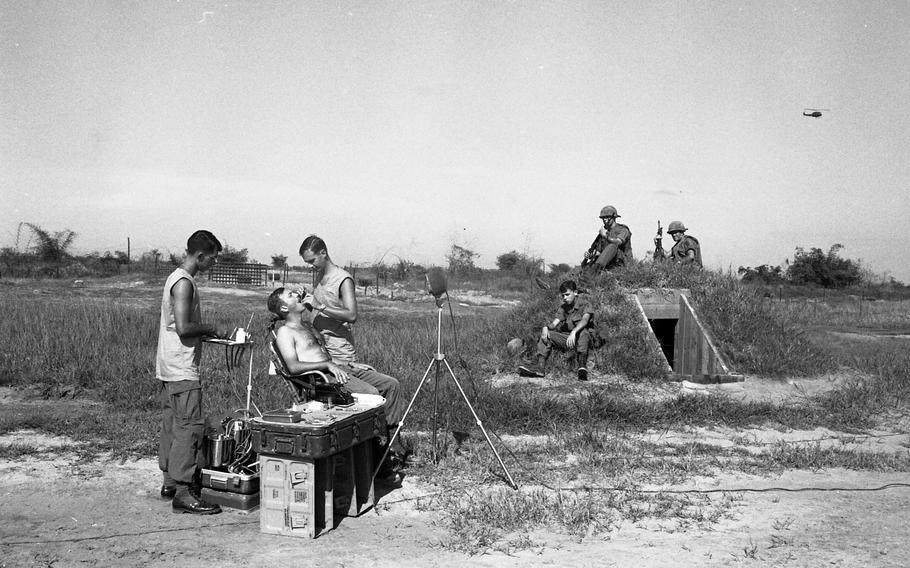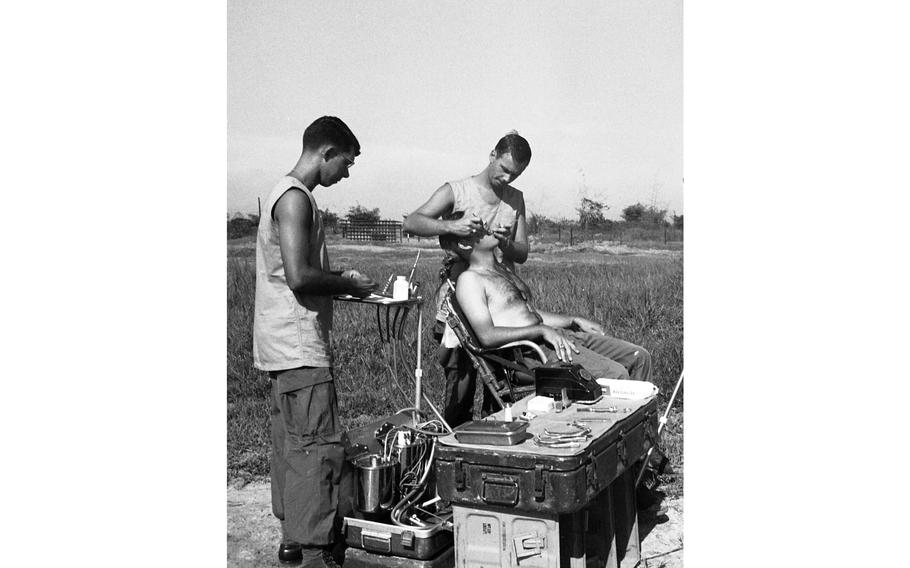
Capt. Earle Yeamans examines an infantryman’s teeth as his fellow soldiers look on. (Bob Cutts/Stars and Stripes)
This article first appeared in the Stars and Stripes Pacific edition, Oct. 21, 1968. It is republished unedited in its original form.
DI AN, Vietnam — The 1st Inf. Div. trooper moaned in pain as the man in the medical tunic bent over his head. Chrome instruments flashed in the dingy light.
The deep-throated “Boom!” of incoming mortar rounds shook dust from the tent flaps, and the doc worried momentarily about keeping the pincers and scissors clean. It was impossible.
The company exec, a captain, ran into the tent and gasped something about “Y’all right Doc?” Yeamans never stopped the swift, sure strokes of his hands. “Yeah. Fine.” The captain disappeared — there were other men to worry about.
“There,” Yeamans whispered at last, sweat glistening on his forehead, “Got it.” He held up the tweezers to the light, and his assistant could see right away what it was — a cavity-blackened molar.
“Now,” Yeamans went on, “you won’t have any more trouble. Just brush your teeth regularly, like we told you, and you won’t get any more cavities. Your teeth aren’t bad at all.”
“Thanks, Doc,” said the GI. He wiped his mouth, slipped out of the dentist’s chair and disappeared.
“Well,” said Capt. Earle Yeamans, 1st Inf. Div. dentist, “Who’s next? Let’s get to that corporal with all the fillings.”
It doesn’t exactly happen every day to Yeamans, the Big Red One’s traveling dentist. “We didn’t know until we got back to Di An that we were under mortar attack at all. We were pretty lucky, I guess. I don’t know what I’d have done if they’d told me.”
But drilling and filling cavities and pulling teeth are in his “traveling bag” — three times a month, Yeamans and his assistant, Spec. 5 Richard Ackley, hoist their 600-pound portable dentist’s office aboard a helicopter and head for the boonies — to add electric drills and evil looking picks to the infantryman’s normal ration of combat grief.
Yeamans visits night defensive positions of the Big Red One, setting up generator and air pump operated drills, suction tubes, operating lights, instrument tables and collapsible dentist’s chair to pull “preventive maintenance” on the teeth of entire companies.
He stays in an area three or four days, examining every man in the unit and scheduling appointments.

Three times a month Capt. and Dr. Earle Yeamans, the Big Red One’s travelling dentist, and his assistant Spc. 5 Richard Ackley, hoist their 600-pound portable dentist’s office aboard a helicopter and head for the boonies. They stay in the area three or four days, examining every man in the unit and scheduling appointments. (Bob Cutts/Stars and Stripes)
“What it’s for,” he says, “is to try to keep the men out with their units — these outfits need every man they’ve got— and still get them good dental care. It relieves emergencies that might later take a man out of action for days, and it’s a great morale factor. We try to make it as easy as possible for them to get dental care.
“We treat only emergencies, or those likely to become emergencies — the rest, we schedule for return to base camps in stand-down periods. But we can give them pretty good care, really, with this stuff — we can put in permanent fillings, make extractions, even do minor oral surgery.”
Doc Yeamans, who often spends 12 hours a day bending over his portable chair, under trees and in tents, says “the men really are glad to see us.
Nobody can remember exactly what the Army calls its new tooth goo, says Yeamans, but he’s heard some pretty racy nicknames from battle-hardened old sergeants brushing their molars with the Pfcs out in public drill, under the benevolent gaze of the doc. Only one seems to be almost universally popular: “Yecchhh!”
Looking for Stars and Stripes’ coverage of the Vietnam War? Subscribe to Stars and Stripes’ historic newspaper archive! We have digitized our 1948-1999 European and Pacific editions, as well as several of our WWII editions and made them available online through https://starsandstripes.newspaperarchive.com/